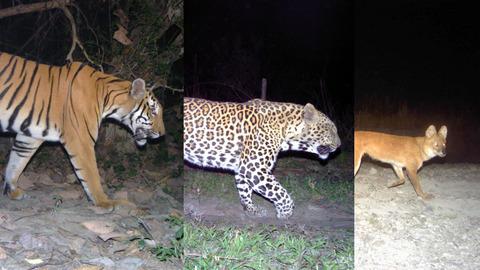当前位置:
X-MOL 学术
›
Anim. Conserv.
›
论文详情
Our official English website, www.x-mol.net, welcomes your
feedback! (Note: you will need to create a separate account there.)
Inferring patterns of sympatry among large carnivores in Manas National Park – a prey-rich habitat influenced by anthropogenic disturbances
Animal Conservation ( IF 2.8 ) Pub Date : 2020-11-23 , DOI: 10.1111/acv.12662 D. Lahkar 1, 2 , M. F. Ahmed 1 , R. H. Begum 2 , S. K. Das 3 , A. Harihar 4, 5
Animal Conservation ( IF 2.8 ) Pub Date : 2020-11-23 , DOI: 10.1111/acv.12662 D. Lahkar 1, 2 , M. F. Ahmed 1 , R. H. Begum 2 , S. K. Das 3 , A. Harihar 4, 5
Affiliation

|
Inferring the mechanisms that facilitate sympatry amongst large mammalian carnivores in anthropogenically altered habitats is critical if conservation initiatives aimed to recover populations are to be effective. In this study, we assessed the utilization of space, time and prey resources by tigers Panthera tigris, leopards P. pardus and dholes Cuon alpinus in Manas National Park (MNP), India – a site where prey densities are not limiting, yet anthropogenic influences alter the spatial and temporal behaviour of prey. We use photographic capture data and predator scats collected over three sampling years (2014–15, 2015–16 and 2016–17) to assess patterns of (a) spatial use using a multispecies species occupancy framework, (b) time–activity patterns and overlap between predators and prey using non-parametric circular kernel-density functions, (c) fine-scale spatio-temporal behaviour by comparing time-to-encounters of subsequent events and (d) predator diets by analysing prey remains in predator scats. Our results highlight that the predators segregate through fine-scale spatio-temporal avoidance rather than displaying population-level changes in space-use, activity patterns or food habits. Overlap in space-use between tigers and leopards was high and time–activity patterns of the predators closely matched those of prey, suggesting that predators likely maximize resource acquisition in this prey-rich environment. Ungulate prey dominated the diet of predators, resulting in the high dietary overlap. From our results, we infer patterns of sympatry among large carnivores in the face of anthropogenic influences and highlight the need to understand interspecific interactions within a community before initiating conservation actions aimed at recovering these endangered species.
中文翻译:

推断玛纳斯国家公园大型食肉动物之间的同情模式——受人为干扰影响的猎物丰富的栖息地
如果旨在恢复种群的保护举措有效,那么推断在人为改变的栖息地中促进大型哺乳动物食肉动物之间的同情的机制至关重要。在这项研究中,我们评估了虎Panthera tigris、豹P. pardus和 dholes Cuon alpinus对空间、时间和猎物资源的利用 印度玛纳斯国家公园 (MNP) 的猎物密度不受限制,但人为影响改变了猎物的时空行为。我们使用在三个采样年(2014-15、2015-16 和 2016-17)收集的摄影捕获数据和捕食者粪便来评估(a)使用多物种物种占有框架的空间使用模式,(b)时间-活动模式和捕食者和猎物之间的重叠使用非参数圆形核密度函数,(c) 通过比较后续事件的时间来获得精细的时空行为,以及 (d) 通过分析捕食者粪便中的猎物残留物来分析捕食者的饮食。我们的结果强调,捕食者通过精细的时空回避进行隔离,而不是显示空间使用、活动模式或饮食习惯的人口水平变化。老虎和豹子之间的空间使用重叠度很高,捕食者的时间活动模式与猎物的时间活动模式非常匹配,这表明捕食者可能会在这个猎物丰富的环境中最大限度地获取资源。有蹄类猎物主宰了捕食者的饮食,导致高饮食重叠。从我们的结果中,我们推断大型食肉动物在面对人为影响时的同情模式,并强调在启动旨在恢复这些濒危物种的保护行动之前了解社区内种间相互作用的必要性。导致高膳食重叠。从我们的结果中,我们推断大型食肉动物在面对人为影响时的同情模式,并强调在启动旨在恢复这些濒危物种的保护行动之前了解社区内种间相互作用的必要性。导致高膳食重叠。从我们的结果中,我们推断大型食肉动物在面对人为影响时的同情模式,并强调在启动旨在恢复这些濒危物种的保护行动之前了解社区内种间相互作用的必要性。
更新日期:2020-11-23
中文翻译:

推断玛纳斯国家公园大型食肉动物之间的同情模式——受人为干扰影响的猎物丰富的栖息地
如果旨在恢复种群的保护举措有效,那么推断在人为改变的栖息地中促进大型哺乳动物食肉动物之间的同情的机制至关重要。在这项研究中,我们评估了虎Panthera tigris、豹P. pardus和 dholes Cuon alpinus对空间、时间和猎物资源的利用 印度玛纳斯国家公园 (MNP) 的猎物密度不受限制,但人为影响改变了猎物的时空行为。我们使用在三个采样年(2014-15、2015-16 和 2016-17)收集的摄影捕获数据和捕食者粪便来评估(a)使用多物种物种占有框架的空间使用模式,(b)时间-活动模式和捕食者和猎物之间的重叠使用非参数圆形核密度函数,(c) 通过比较后续事件的时间来获得精细的时空行为,以及 (d) 通过分析捕食者粪便中的猎物残留物来分析捕食者的饮食。我们的结果强调,捕食者通过精细的时空回避进行隔离,而不是显示空间使用、活动模式或饮食习惯的人口水平变化。老虎和豹子之间的空间使用重叠度很高,捕食者的时间活动模式与猎物的时间活动模式非常匹配,这表明捕食者可能会在这个猎物丰富的环境中最大限度地获取资源。有蹄类猎物主宰了捕食者的饮食,导致高饮食重叠。从我们的结果中,我们推断大型食肉动物在面对人为影响时的同情模式,并强调在启动旨在恢复这些濒危物种的保护行动之前了解社区内种间相互作用的必要性。导致高膳食重叠。从我们的结果中,我们推断大型食肉动物在面对人为影响时的同情模式,并强调在启动旨在恢复这些濒危物种的保护行动之前了解社区内种间相互作用的必要性。导致高膳食重叠。从我们的结果中,我们推断大型食肉动物在面对人为影响时的同情模式,并强调在启动旨在恢复这些濒危物种的保护行动之前了解社区内种间相互作用的必要性。









































 京公网安备 11010802027423号
京公网安备 11010802027423号